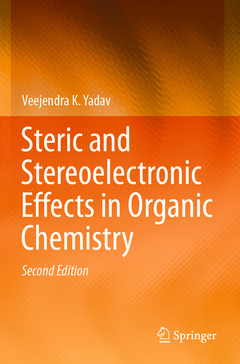Steric and Stereoelectronic Effects in Organic Chemistry (2nd Ed., 2nd ed. 2021)
Auteur : Yadav Veejendra K.

In this second edition, the author has thoroughly updated each chapter and expanded the content with addition of three new chapters. This book comments on several key aspects of stereochemical control of organic reactions in measured detail to allow the reader easily grasp these concepts. In addition, emphasis is given to key information and important aspects of steric and stereoelectronic effects and their control on conformational profile and reactivity features. This book is not only an indispensable resource for advanced undergraduate and graduate students studying the stereochemical aspects of organic reactions, but also a good reference book for all organic chemists in both industry and academia.
Chapter-I: Steric and stereoelectronic control of molecular structures and organic reactions
1. Influence of steric effects on structures
2. Influence of stereoelectronic effects on reactions3. Evaluation of the numerical value of anomeric effect
4. Influence of anomeric effect on conformational preferences
5. Influence of anomeric effect on conformational Reactivities
6. Conformations of mono and dithioacetals
7. Conformations of mono and diazaacetals8. Antiperiplanar effects arising from C-Si, C-Ge and C-Sn bonds
Chapter-II. Reactions at saturated and unsaturated carbons
1. Inter and intramolecular reactions at saturated carbons
2. Intermolecular reactions of epoxides
3. Intramolecular reactions of epoxides4. Baldwin’s rules for ring closure at saturated and unsaturated Carbons
5. SN2’ reaction (reaction at unsaturated carbon)
6. SN2 reactions of cyclopropanes activated by two geminal carbonyl groups
7. Reactions involving consecutive intramolecular SN2 reactions leading to rearrangement8. Dual activation for skeletal rearrangement
9. Solvolysis with neighbouring group participation10. Rearrangement originating from oxiranes under Lewis acid conditions
11. Rearrangement via classical vs non-classical carbocations
12. Tandem skeletal changes and polyene cyclization
13. Application of Baldwin’s 5-exo-trig cyclization14. Stereocontrol in multi-cyclisation
15. Reaction at sp carbon
16. Beckman rearrangement
17. Curtius rearrangement
Chapter-III: Diastereoselectivity in organic reactions
1. Cram’s model for asymmetric synthesis
2. Anh-Felkin modification of Cram’s model for asymmetric synthesis
3. Cieplak’s model for diastereoselectivity
4. Houk’s transition state and electrostatic models for diastereoselectivity
5. Cation coordination model for diastereoselectivity
Chapter-IV: A(1,2) and A(1,3) strains
1. Introduction
2. A(1,2) strain
3. Stereocontrol in reactions on account of A(1,2) strain
4. A(1,3) strain
5. Stereocontrol in reactions on account of A(1,3) strain
6. A(1,3) strain in amides and its consequences on diastereoselectivity
Chapter-V: The conservation of orbital symmetry (Woodward-Hoffmann rules)
1. Introduction
2. Orbitals and symmetry considerations
0. 2 + 2 reaction
3. Electrocyclic ring closure and ring opening reactions
1. 4 + 2 reaction (Diels-Alder cycloaddition reaction)
Chapter-VI: The overlap component of the stereoelectronic factor vis-à-vis the conservation of orbital symmetry rules
1. Introduction
2. Steric effects in the thermal fragmentation of cis-3,6-dimethyl-3,6-dihydropyridazine
3. Orbital overlap effects in the thermal fragmentation of cyclopropanated and cyclobutanated cis-3,6-dimethyl-3,6-dihydropyridazine
4. Orbital overlap effects in [1,5]-sigmatropic shifts
5. Difficulties experienced with the [1,5]-sigmatropic shift in cyclobutanated species
Chapter VII: Torquoselectivity of conrotatory ring opening in 3-substituted cyclobutenes
1. Activation Barrier Approach to Torquoselectivity
2. TS-NBO Approach to Torquoselectivity
3. Conformational effects on Torquoselectivity
Chapter-VIII: Hammett Substituent Constants 1. Hammett substituent constants for benzoic acids (m and p) 2. Hammett substituent constants for phenylacetic and 3-arylpropionic acids3. Hammett substituent constants and free energy relationship
4. Hammett substituent constants and reaction pathway assessment
5. Hammett substituent constants + and -
6. Hammett substituent constants and ester hydrolysis mechanismChapter-IX. Relative aromaticity of pyrrole, furan, thiophene and selenophene, and their Diels-Alder stereoselectivity
1. Introduction
2. Heteroatom lone pair interaction with the ring p bonds in the ground state
3. DA reactions of pyrrole, furan, thiophene and selenophene with maleic anhydride
4. 4.1. DA reactions of cyclopentadiene, silole and germole with maleic anhydride
4.2 DA reactions of cyclopentadiene, silole and germole with acetylene-1,2-bisnitrile and
acetylene
5.1. DA reactions of 1,3-cyclohexadiene and 1,3-cycloheptadiene with maleic anhydride
5.2. DA reactions of 1,3-cyclohexadiene and 1,3-cycloheptadiene with acetylene-1,2-bisnitrile and
acetylene
6. DA reactions of 1,3-cyclohexadiene and 1,3-cyclooctadiene-6-yne with acetylene-1,2-bisnitrileand acetylene
7. Evaluation of the allylic interaction in the DA reactions of acyclic dienes
8. DA reactions of 6-oxa-, 6-aza-, 6-thia- and 6-selena-1,3-cycloheptadiene with maleic anhydride
9. DA reactions of 2,3-cyclopropano-, 2,3-cyclobutano- and 2,3-cyclopentano-6-oxa-1,3-cycloheptadienes with maleic anhydride10. DA reactions of benzene, pyridine and 1,4-diazine with acetylene-1,2-bisnitrile and acetylene
11. DA reactions of naphthalene, 1-azanaphthalene and 1,4-diazanaphthalene with cyclopropene
12. DA reactions of anthracene, 9-azaanthracene and 9,10-diazaanthracene with cyclopropene13. DA reactions of benzene, naphthalene, and anthracene with acetylene-1,2-bisnitrile
14. Deformation energy considerations in the DA reactions of five-membered heterocycles with acetylene-1,2-bisnitrile
15. DA reactions of thiophene 1,1-dioxide with maleic anhydride16. Reaction profile and solvent effects on the diastereoselectivity of DA reactions of five-membered heterocycles with maleic anhydride
Chapter-X: Miscellaneous
1. Spiroconjugation
2. Periselectivity
3. Ambident nucleophiles
4. Ambident electrophiles
0. -Effect
5. Carbenes 6. Hammond postulate 7. Curtin-Hammett principle 8. Diastereotopic, homotopic, and enantiotopic substituents 9. Captodative effectVeejendra K. Yadav earned his PhD under the mentorship of Dr. Sukh Dev in 1982. He carried out his postdoctoral research at University of Calgary, Memorial University of Newfoundland, University of Ottawa, and University of Southern California over the years 1983-1990 before joining Indian Institute of Technology Kanpur (IITK) as Assistant Professor in late 1990. Over the years, he rose through ranks and became full Professor in 2001. He has taught both undergraduate and postgraduate students at IITK over the past thirty years, and has remained a popular teacher among the students throughout. His research focuses on development of new reactions with emphasis on the construction of pharmacophores, synthesis of biologically active molecules, computational-cum-experimental investigation of facial selectivity, and computational investigation of reaction mechanisms. He has three international patents and 100 research papers in peer reviewed journals to his credit.
Explains steric and stereoelectronic effects which control reactions
Offers clear visual effects for easy understanding
Updated and expanded 2nd edition
Date de parution : 07-2022
Ouvrage de 262 p.
15.5x23.5 cm
Date de parution : 07-2021
Ouvrage de 262 p.
15.5x23.5 cm



